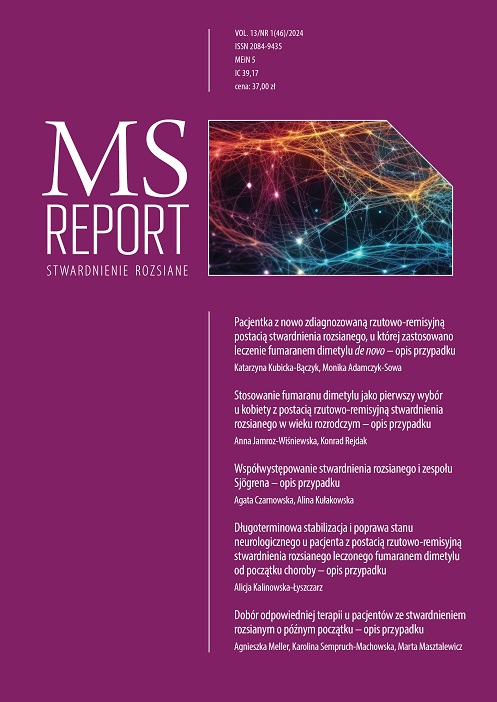Fumaran dimetylu w leczeniu postaci rzutowo-remisyjnej stwardnienia rozsianego – opis przypadku Opis przypadku
##plugins.themes.bootstrap3.article.main##
Abstrakt
Opis przypadku przedstawia historię obecnie 38-letniej kobiety, u której 15 lat temu rozpoznano postać rzutowo-remisyjną stwardnienia rozsianego. Wówczas w badaniu metodą rezonansu magnetycznego mózgu uwidoczniono zmiany demielinizacyjne w lokalizacji nad- i podnamiotowej, a w płynie mózgowo-rdzeniowym stwierdzono obecność prążków oligoklonalnych. Pacjentka zdecydowała się na leczenie modyfikujące przebieg choroby dopiero w 2018 r. po ciężkim rzucie móżdżkowo-rdzeniowym, kiedy wdrożono terapię fumaranem dimetylu w ramach programu lekowego NFZ. W ciągu kolejnych 5 lat u pacjentki uzyskano status NEDA-3 (brak nowych rzutów choroby, brak nowych zmian demielinizacyjnych w kontrolnych corocznych badaniach metodą rezonansu magnetycznego mózgu oraz brak cech progresji niepełnosprawności w skali EDSS). W kontekście opisu przypadku przedstawiono wybrane aspekty leczenia postaci rzutowo-remisyjnej stwardnienia rozsianego fumaranem dimetylu, ze szczególnym uwzględnieniem profilu prognostycznego przebiegu choroby oraz planów prokreacyjnych.
##plugins.themes.bootstrap3.article.details##
Copyright © by Medical Education. All rights reserved.
Bibliografia
2. Rotstein D, Montalban X. Reaching an evidence-based prognosis for personalized treatment of multiple sclerosis. Nat Rev Neurol. 2019; 15: 287-300.
3. Buron MD, Chalmer TA, Sellebjerg F et al. Comparative effectiveness of teriflunomide and dimethyl fumarate. Neurology. 2019; 92: e1811-20.
4. Braune S, Grimm S, van Hövell P et al. Comparative effectiveness of delayed-release dimethyl fumarate versus interferon, glatiramer acetate, teriflunomide, or fingolimod: results from the German NeuroTransData registry. J Neurol. 2018; 265: 2980-92.
5. Gold R, Arnold DL, Bar-Or A et al. Long-term safety and efficacy of dimethyl fumarate for up to 13 years in patients with relapsing-remitting multiple sclerosis: Final ENDORSE study results. Mult Scler J. 2022; 28: 801-16.
6. Spelman T, Magyari M, Piehl F et al. Treatment Escalation vs Immediate Initiation of Highly Effective Treatment for Patients With Relapsing-Remitting Multiple Sclerosis. JAMA Neurol. 2021; 78: 1197.
7. Iaffaldano P, Lucisano G, Caputo F et al. Long-term disability trajectories in relapsing multiple sclerosis patients treated with early intensive or escalation treatment strategies. Ther Adv Neurol Disord. 2021; 14: 175628642110195.
8. Giovannoni G, Butzkueven H, Dhib-Jalbut S et al. Brain health: time matters in multiple sclerosis. Mult Scler Relat Disord. 2016; 9: S5-48.
9. Nakamura K, Mokliatchouk O, Arnold DL et al. Effects of Dimethyl Fumarate on Brain Atrophy in Relapsing-Remitting Multiple Sclerosis: Pooled Analysis Phase 3 DEFINE and CONFIRM Studies. Front Neurol. 2022; 13: 809273.
10. Marastoni D, Crescenzo F, Pisani AI et al. Two years’ effect of dimethyl fumarate on focal and diffuse gray matter pathology in multiple sclerosis. Mult Scler J. 2022; 28: 2090-8.
11. Chylińska M, Komendziński J, Wyszomirski A et al. Brain Atrophy as an Outcome of Disease-Modifying Therapy for Remitting-Relapsing Multiple Sclerosis. Mult Scler Int. 2023; 2023: 4130557.
12. Carlomagno V, Mirabella M, Lucchini M. Current Status of Oral Disease-Modifying Treatment Effects on Cognitive Outcomes in Multiple Sclerosis: A Scoping Review. Bioengineering. 2023; 10: 848.
13. Alvarez E, Nair KV, Hoyt BD et al. Brain atrophy rates in patients with multiple sclerosis on long term natalizumab resembles healthy controls. Mult Scler Relat Disord. 2021; 55: 103170.
14. Houtchens MK, Edwards NC, Schneider G et al. Pregnancy rates and outcomes in women with and without MS in the United States. Neurology. 2018; 91: e1559-e1569.
15. Andersen JB, Sellebjerg F, Magyari M. Pregnancy outcomes after early fetal exposure to injectable first-line treatments, dimethyl fumarate, or natalizumab in Danish women with multiple sclerosis. Eur J Neurol. 2023; 30: 162-71.
16. Hellwig K, Rog D, McGuigan C et al. Interim Analysis of Pregnancy Outcomes After Exposure to Dimethyl Fumarate in a Prospective International Registry. Neurol Neuroimmunol Neuroinflammation. 2022; 9: e1114.
17. Hemmer B. Diagnose und Therapie der Multiplen Sklerose, Neuromyelitis-opticaSpektrum-Erkrankungen und MOG-IgG-assoziierten Erkrankungen. Leitlinien für Diagnostik und Ther der Neurol Deutsch Gesellschaft für Neurol. 2023; AWMF-Registernummer: 030/050.
18. Montalban X. Update of the ECTRIMS/EAN Guidelines on the Treatment of Multiple Sclerosis. Updated recommendations. ECTRIMS Congress, 2021.
19. Dobson R, Rog D, Ovadia C et al. Anti-CD20 therapies in pregnancy and breast feeding: a review and ABN guidelines. Pract Neurol. 2023; 23: 6-14.
20. Farber RS, Sand IK. Optimizing the initial choice and timing of therapy in relapsing-remitting multiple sclerosis. Ther Adv Neurol Disord. 2015; 8: 212-32.
21. Mowry E. PS01.01 – Escalation Versus Aggressive Treatment Algorithms. ECTRIMS Congress, 2020.
22. Giovannoni G. PS09.01 – Customized Management of Individuals with MS Using Approved Therapies. ECTRIMS Congress, 2020.
23. Baldassari L, Cohen J. Chapter 11. Approach to Disease Modifying Therapy. In: Multiple Sclerosis and Related Disorders, Second Edition. 2019.

